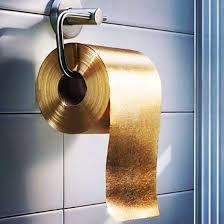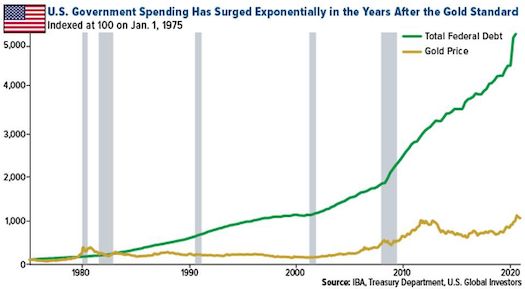 This year will mark the 50th anniversary of President Richard Nixon severing America – and the world – from its last tie to the gold standard. The rapid devaluing of the dollar is the most obvious result. But another consequence has been an enormous national debt that continues to grow at a staggering pace. Most people don’t realize it, but this is a direct and intentional result of the current fiat money system.
This year will mark the 50th anniversary of President Richard Nixon severing America – and the world – from its last tie to the gold standard. The rapid devaluing of the dollar is the most obvious result. But another consequence has been an enormous national debt that continues to grow at a staggering pace. Most people don’t realize it, but this is a direct and intentional result of the current fiat money system.
In 1971, Nixon put the final nail in the coffin of the gold standard, but President Franklin D. Roosevelt put us on the path. On April 5, 1933, Roosevelt signed Executive Order 6102. It was touted as a measure to stop gold hoarding, but it was in reality, a massive gold confiscation scheme. The order required private citizens, partnerships, associations and corporations to turn in all but small amounts of gold to the Federal Reserve in exchange for $20.67 per ounce.
This infamous executive order was just one of several steps Roosevelt took toward ending the gold standard in the US.
With the dollar tied to gold, the Federal Reserve found it difficult to increase the money supply during the Great Depression. It couldn’t simply fire up the printing press as it can today. The Federal Reserve Act required all notes have 40% gold backing. But the Fed was low on gold and up against the limit. By stealing gold from the public, the Fed was able to boost its gold holdings.
EO 6102 followed on the heels of an order Roosevelt issued just weeks before prohibiting banks from paying out or exporting gold. Just two months after the enactment of EO 6102, the US effectively went off the gold standard when Congress enacted a joint resolution erasing the right of creditors to demand payment in gold. Then, in 1934, the government’s fixed price for gold was increased to $35 per ounce. This effectively increased the value of gold on the Federal Reserve’s balance sheet by 69%. By increasing its gold stores through the confiscation of private gold holdings, and declaring a higher exchange rate, the Fed could circulate more notes. In effect, the hoarding of gold by the government allowed it to inflate the money supply.
President Richard Nixon laid the gold standard to rest for good when he slammed the “gold window” shut, severing the last ties the dollar had to gold. Nixon uncoupled gold from its fixed $35 price and suspended the convertibility of dollars into gold by foreign governments and central banks.
At this point, the dollar became effectively free-floating, measured only by comparing it to other fiat currencies.
According to the Consumer Price Index data released by the Bureau Labor of Statistics, the dollar has lost more than 80% of its value since Nixon’s fateful decision. Meanwhile, the dollar value of gold has gone from $35 an ounce to over $1,800.
This is considered an acceptable tradeoff because a free-floating currency is exactly what the government needed. It would be impossible to fund the American welfare and warfare state with a currency constrained by gold. With the dollar untethered from any fixed standard, Uncle Sam could create as many dollars as it pleased in order to fund all of its massive social and military programs. With a free-floating fiat currency, the US government can borrow as much money as it needs, knowing that the central bank will always be there to monetize the debt and backstock the spending.
And that’s exactly what has happened.
As Frank Holmes put it in an article published by Forbes, “there’s been a significant and growing lack of discipline when it comes to government spending,” since Nixon’s fateful act.
“Before 1971, there was a natural limit to how much money could be printed. New issuances were dependent on the amount of gold sitting in the nation’s coffers. Today, with the dollar backed not by a hard asset but by the ‘full faith and credit’ of the U.S. government, the federal debt is closing in on an astronomical $28 trillion, which is more than 130% of the size of the US economy.”
To put this into perspective, in 1960, the national debt was just a little over half the size of the US economy.
 This is clearly unsustainable. But the US isn’t about to go back onto a gold standard. And Joe Biden isn’t going to rein in the spending. In fact, he will almost certainly ramp it up. What little fiscal restraint that existed has been washed away by the tidal wave of the coronavirus pandemic.
This is clearly unsustainable. But the US isn’t about to go back onto a gold standard. And Joe Biden isn’t going to rein in the spending. In fact, he will almost certainly ramp it up. What little fiscal restraint that existed has been washed away by the tidal wave of the coronavirus pandemic.
This is not good for the future of the US economy. At some point, the money printing game will come to its inevitable end. As Peter Schiff has been warning, the inflation monster will take over and the dollar will crash.
This is why it’s a good idea to own gold. As Holmes put it —
“For now, we’re left with the current monetary system of unlimited money-printing, which in turn makes each US dollar less valuable and each ounce of gold more valuable.”
[Got physical… close at hand?]
Let’s do something about that…
 The Edge of Darkness is heard at 8:00 p.m. (Eastern Time), each Monday through Friday on Republic Broadcasting Network. Jeffrey Bennett, host of the program will be sharing over 60 years of his personal experience in the precious metals markets, in addition to educational commentary regarding YOUR financial health and welfare.
The Edge of Darkness is heard at 8:00 p.m. (Eastern Time), each Monday through Friday on Republic Broadcasting Network. Jeffrey Bennett, host of the program will be sharing over 60 years of his personal experience in the precious metals markets, in addition to educational commentary regarding YOUR financial health and welfare.
Kettle Moraine, Ltd.
P.O. Box 579
Litchfield Park, AZ 85340
602-799-8214
kettlemoraineltd@cox.net
Written by Michael Maharrey for Schiff Gold ~ January 26, 2021









